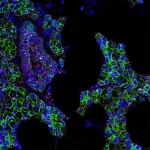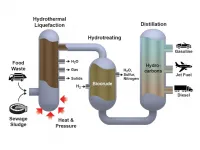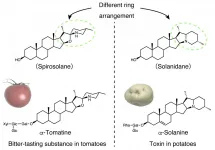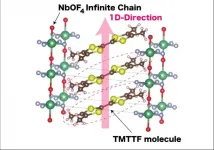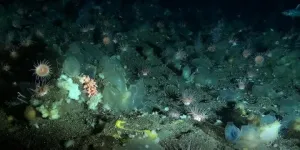Study of NCOA3 yields novel findings of melanoma progression
Pre-clinical findings from patient-derived xenograft (PDX) model at Sutter's California Pacific Medical Center suggest new model of ultraviolet radiation-induced melanoma susceptibility
2021-03-25
(Press-News.org) For the first time, activation of nuclear receptor coactivator 3 (NCOA3) has been shown to promote the development of melanoma through regulation of ultraviolet radiation (UVR) sensitivity, cell cycle progression and circumvention of the DNA damage response. Results of a pre-clinical study led by Mohammed Kashani-Sabet, M.D., Medical Director of the Cancer Center at Sutter's California Pacific Medical Center (CPMC) in San Francisco, CA were published online today in Cancer Research, a journal of the American Association for Cancer Research.
"Our research suggests a previously unreported mechanism by which NCOA3 regulates the DNA damage response and acts as a potential therapeutic target in melanoma, whereby activation of NCOA3 contributes to melanoma development following exposure to ultraviolet light," says Dr. Kashani-Sabet, who collaborated with scientists at CPMC's Research Institute, the University Duisburg-Essen in Germany and the Knight Cancer Institute in Portland, OR for the study.
Epidemiological studies suggest a role for UVR in melanoma causation, supported by whole genome sequencing studies demonstrating a high burden of UV-signature mutations. But the precise molecular mechanisms by which melanoma develops following UVR remain poorly understood, necessitating the identification of additional molecular factors that govern both UV and melanoma susceptibility.
NCOA3 (also known as AIB1 or SRC-3) is a member of the nuclear hormone receptor coactivator family, and regulates gene expression through its interaction with various transcription factors. NCOA3 was initially shown to be amplified in breast cancer, and has a demonstrated oncogenic role in various solid tumors. However, a role for NCOA3 in UVR-mediated melanomagenesis has not been previously demonstrated.
By utilizing a combination of in vitro, in vivo and PDX modelling of melanomagenesis, Dr. Kashani and colleagues assessed the effects of regulating NCOA3 expression in human melanoma cells as well as in melanocytes, identifying multiple oncogenic pathways regulated by NCOA3 in melanoma progression.
Results showed that down-regulation of NCOA3 expression, either by genetic silencing or small molecule inhibition, significantly suppressed melanoma proliferation in melanoma cell lines and PDXs. NCOA3 silencing suppressed expression of xeroderma pigmentosum C and increased melanoma cell sensitivity to UVR. Suppression of NCOA3 expression led to activation of DDR effectors and reduced expression of cyclin B1, resulting in G2/M arrest and mitotic catastrophe.
A single nucleotide polymorphism in NCOA3 (T960T) was associated with decreased melanoma risk, given a significantly lower prevalence in a familial melanoma cohort than in a control cohort without cancer. Additional studies suggest this polymorphism decreases NCOA3 protein production, and is accompanied by increased sensitivity to ultraviolet light--resulting in cell death.
Taken together, these findings are consistent with a model of melanoma initiation whereby elevated NCOA3 expression promotes melanocyte survival following exposure to UVR. This survival advantage enables accumulation of UVR-mediated DNA damage. Over the lifetime of an individual who is susceptible to melanoma, significant exposure to UVR can result in both the high mutational burden and uncontrolled cellular proliferation that characterize the disease. By contrast, these effects are attenuated following expression of the T960T polymorphism, with increased sensitivity to UV-mediated cell death, thereby protecting against the carcinogenic effects of UVR.
"Our results demonstrate an unprecedented role for a molecular marker in distinct stages of tumor progression. These results identify NCOA3 as a candidate susceptibility marker for melanoma, as a potential diagnostic marker, as a prognostic marker of melanoma survival and as a target for therapy. We propose a critical role for NCOA3 in UVR-mediated melanomagenesis, and as a rational therapeutic target for melanoma," says Dr. Kashani-Sabet.
Skin cancer is the most common type of cancer worldwide. Melanoma accounts for about 1% of skin cancers but causes a large majority of skin cancer deaths. This year, approximately 106,000 Americans will be diagnosed with melanoma.
"We're committed to advancing this research to help guide and inform care for the treatment of Sutter patients with melanoma and other patients worldwide," says Dr. Kashani-Sabet.
INFORMATION:
ELSE PRESS RELEASES FROM THIS DATE:
2021-03-25
Durham, NC - Depletion of a certain type of stem cell in the womb lining during pregnancy could be a significant factor behind miscarriage, according to a study released today in STEM CELLS. The study, by researchers at Warwick Medical School, University of Warwick, Coventry, England, reports on how recurrent pregnancy loss is a result of the loss of decidual precursor cells prior to conception.
"This raises the possibility that they can be harnessed to prevent pregnancy disorders," said corresponding author Jan J. Brosens, M.D., Ph.D., professor of obstetrics and gynecology at Warwick Medical School (WMS).
The womb lining - or endometrium - is a ...
2021-03-25
Perhaps the best hope for slowing climate change - capturing and storing carbon dioxide emissions underground - has remained elusive due in part to uncertainty about its economic feasibility.
In an effort to provide clarity on this point, researchers at Stanford University and Carnegie Mellon University have estimated the energy demands involved with a critical stage of the process. (Watch video here: https://www.youtube.com/watch?v=-ZPIwwQs9aM)
Their findings, published April 8 in Environmental Science & Technology, suggest that managing and ...
2021-03-25
Smoking cigarettes causes 480,000 premature deaths each year in the United States, due mainly to a two-fold risk of cardiovascular disease and a 20-fold risk of lung cancer. Although smoking rates have declined dramatically, there are currently 35 million smokers in the U.S.
In a commentary published in the Ochsner Medical Journal, Charles H. Hennekens, M.D., Dr.PH, senior author, the First Sir Richard Doll Professor, and senior academic advisor in the Schmidt College of Medicine at Florida Atlantic University, and colleagues, highlight how failure to institute smoking cessation in hospitalized patients is a missed opportunity to avoid many premature deaths.
Each year in the U.S., ...
2021-03-25
An international team led by scientists at the National Institutes of Health and the University of North Carolina at Chapel Hill, has found evidence that SARS-CoV-2, the virus that causes COVID-19, infects cells in the mouth.
While it's well known that the upper airways and lungs are primary sites of SARS-CoV-2 infection, there are clues the virus can infect cells in other parts of the body, such as the digestive system, blood vessels, kidneys and, as this new study shows, the mouth. The potential of the virus to infect multiple areas of the body might help explain the wide-ranging symptoms experienced by COVID-19 patients, including oral symptoms such as taste loss, dry mouth and blistering.
Moreover, the findings ...
2021-03-25
RICHLAND, WASH.--A large-scale demonstration converting biocrude to renewable diesel fuel has passed a significant test, operating for more than 2,000 hours continuously without losing effectiveness. Scientists and engineers led by the U.S. Department of Energy's Pacific Northwest National Laboratory conducted the research to show that the process is robust enough to handle many kinds of raw material without failing.
"The biocrude oil came from many different sources, including wastewater sludge from Detroit, and food waste collected from prison and an army base," said John Holladay, a PNNL scientist and co-director of the joint Bioproducts Institute, a collaboration between ...
2021-03-25
LA JOLLA--(March 25, 2021) The brush of an insect's wing is enough to trigger a Venus flytrap to snap shut, but the biology of how these plants sense and respond to touch is still poorly understood, especially at the molecular level. Now, a new study by Salk and Scripps Research scientists identifies what appears to be a key protein involved in touch sensitivity for flytraps and other carnivorous plants.
The findings, published March 16, 2021, in the journal eLife, help explain a critical process that has long puzzled botanists. This could help scientists better understand how plants of all kinds sense and respond to mechanical stimulation, and could also have a potential application in medical therapies that mechanically stimulate human cells such as neurons.
"We know that plants ...
2021-03-25
A multi-institutional collaboration has revealed that α-solanine, a toxic compound found in potato plants, is a divergent of the bitter-tasting α-tomatine, which is found in tomato plants. The research group included Associate Professor MIZUTANI Masaharu and Researcher AKIYAMA Ryota et al. of Kobe University's Graduate School of Agricultural Science, Assistant Professor WATANABE Bunta of Kyoto University's Institute for Chemical Research, Senior Research Scientist UMEMOTO Naoyuki of the RIKEN Center for Sustainable Resource Science, and Professor MURANAKA Toshiya of Osaka University's Graduate School of Engineering.
It ...
2021-03-25
Salts are far more complicated than the food seasoning - they can even act as electrical conductors, shuttling current through systems. Extremely well studied and understood, the electrical properties of salts were first theorized in 1834. Now, nearly 200 years later, researchers based in Japan have uncovered a new kind of salt.
The results were published on March 17 in Inorganic Chemistry, a journal of the American Chemical Society.
The researchers were specifically investigating how one-dimensional versions of three-dimensional substances exhibit unique physical phenomena and functionality in a process called the ...
2021-03-25
CORVALLIS, Ore. - A novel analysis of encounters between albatross and commercial fishing vessels across the North Pacific Ocean is giving researchers important new understanding about seabird-vessel interactions that could help reduce harmful encounters.
The new research method, which combines location data from GPS-tagged albatross and commercial fishing vessels, allows researchers to accurately identify bird-vessel encounters and better understand bird behavior, environmental conditions and the characteristics that influence these encounters.
"It is hard to conceptualize how often birds ...
2021-03-25
For the first time, researchers from the SponGES project collected year-round video footage and hydrodynamic data from the mysterious world of a deep-sea sponge ground in the Arctic. Deep-sea sponge grounds are often compared to the rich ecosystems of coral reefs and form true oases. In a world where all light has disappeared and without obvious food sources, they provide a habitat for other invertebrates and a refuge for fish in the otherwise barren landscape. It is still puzzling how these biodiversity hotspots survive in this extreme environment as deep as 1500 metres below the water surface. With over 700 hundred ...
LAST 30 PRESS RELEASES:
[Press-News.org] Study of NCOA3 yields novel findings of melanoma progression
Pre-clinical findings from patient-derived xenograft (PDX) model at Sutter's California Pacific Medical Center suggest new model of ultraviolet radiation-induced melanoma susceptibility


